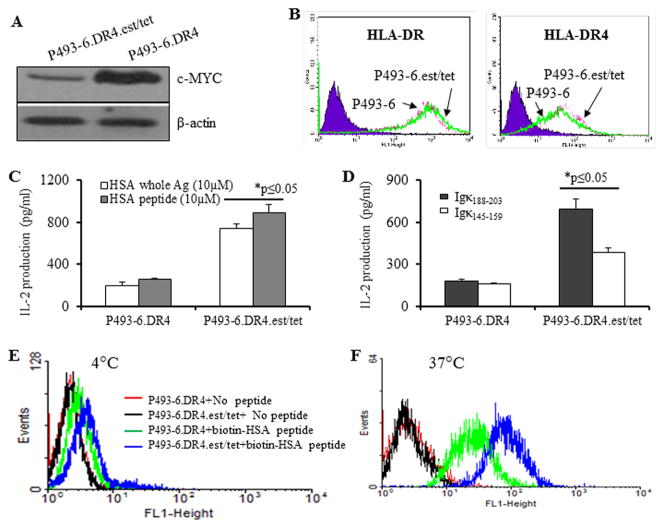Figure 4.
Shift from a LCL- to a BL-like phenotype in P493-6 cells did not alter HLA class II protein expression, but decreased CD4+ T cell recognition via both exogenous and endogenous pathway of HLA class II Ag presentation. A, P493-6 cells were reversibly shifted from a LCL- to a BL-like phenotype by withdrawal and re-addition of estrogen (2μM) plus tetracycline (5μg/ml). Western blot analysis of P493-6.DR4 cells for c-MYC protein expression under c-myclow (est/tet) and c-mychigh (no est/tet) culture conditions. β-actin was used as a loading control. B, Flow cytometric analysis of surface HLA-DR (antibody L243) and HLA-DR4 (antibody 359-F10) molecules in c-myclow (B-LCL) and c-mychigh (BL-like) cells. C, Ag presentation assay showing exogenous presentation of HSA Ag/peptide. P493-6.DR4 cells were first cultured under c-mychigh (P493-6.DR4, without est/tet) and c-myclow (P493-6DR4, with est/tet) conditions, and then incubated with the whole HSA or HSA64-76K peptide for 4h, followed by coculture with the HSA64-76K peptide specific T cell hybridoma (17.9) for 24h. D, Ag presentation assay showing endogenous presentation of Igκ. P493-6.DR4 cells grown under c-mychigh (P493-6.DR4, without est/tet) and c-myclow (P493-6DR4, with est/tet) conditions were cocultured with the HLA-DR4-restricted Igκ188-203 and Igκ145-159 peptide specific T cell hybridomas (2.18a for Igκ188-203 and 1.21 for Igκ145-159 respectively) in the absence of exogenous Ag, for 24h. Supernatants obtained from these T cell assays were tested by ELISA to determine IL-2 levels as a measure of T-cell stimulation. T cell production of IL-2 was expressed as mean pg/ml±SEM. E, Peptide binding assay at 4°C. P493-6.DR4 cells grown under c-mychigh (P493-6.DR4, without est/tet) and c-myclow (P493-6DR4, with est/tet) conditions were incubated with vehicle alone or biotin-labeled HSA64-76K peptide for 24h. F, Peptide binding assay at 37°C. Cells (P493-6.DR4) grown under c-mychigh and c-myclow conditions, washed and fixed with 1% paraformaldehyde, and were incubated with biotin-labeled HSA64-76K peptide for 24, followed by staining with FITC-avidin. After washing, cells were analyzed by flow cytometry as described in the methods. Data are representative of three separate experiments.

